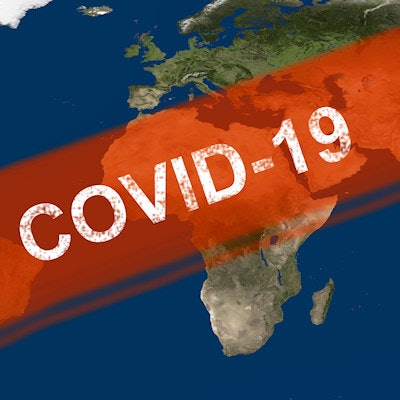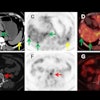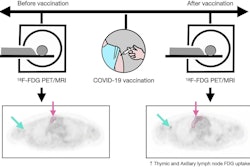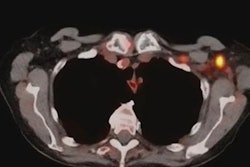
A significant number of cancer patients show F-18 FDG radiotracer uptake in lymph nodes following COVID-19 vaccinations, according to research from Japan presented recently at RSNA 2022 in Chicago.
A group at Kansai Medical University in Japan analyzed data from 181 vaccinated individuals who had received one or two doses of either the Pfizer or Moderna COVID-19 vaccine prior to undergoing F-18 FDG-PET/CT scans. The frequency of increased FDG uptake in lymph nodes was 22%, they found.
"This potential pitfall in PET/CT should be borne in mind during current COVID-19 vaccination programs," said presenter Kaoru Maruyama of the school's Department of Nuclear Medicine and Tracer Kinetics.
F-18 FDG radiotracer uptake in lymph nodes after COVID-19 vaccination has been noted in the literature, with warnings issued that this increased activity may be mistaken for a sign of malignancy. Yet little is known about the frequency and duration of the uptake.
To elucidate the issue, Maruyama and colleagues collected data from 51 healthy vaccinated individuals and 130 cancer patients who underwent diagnostic whole-body FDG-PET/CT scans between May and October 2021. Patients underwent imaging between one and 135 days after vaccinations, and they ranged in age from 29 to 91 years old.
FDG uptake was visually assessed by nuclear medicine experts using a scoring system where uptake in lymph nodes above or equal to liver uptake were considered significant.
The overall frequency of increased FDG uptake by lymph nodes was 22% (39/181 individuals), they found. Lymph node uptake occurred within one day and lasted up to 122 days after vaccinations, according to results.
Specifically, Maruyama highlighted the following findings:
- No uptake in axillary lymph nodes was detected from three days after the first dose, and from four days after the second dose.
- The median onset of local reactions was 17 days after the first dose and 18 days after the second dose.
- The axillary lymph node FDG positive rate was 63% (12 of 19) for individuals at three to 96 days after the first vaccine and 14% (20 of 147) for individuals at two to 135 days after the second dose.
Based on the study, the group recommends that patients with cancer with a propensity to spread to lymph nodes (breast, primary lung cancer, melanoma, and lymphomas) should receive COVID-19 vaccines in the hip or arm contralateral to sites suspected of cancer.
"As COVID-19 vaccination programs expand worldwide, it will be important for oncologists and radiologists to include history of vaccination in interpreting the results of PET imaging studies," she concluded.




















